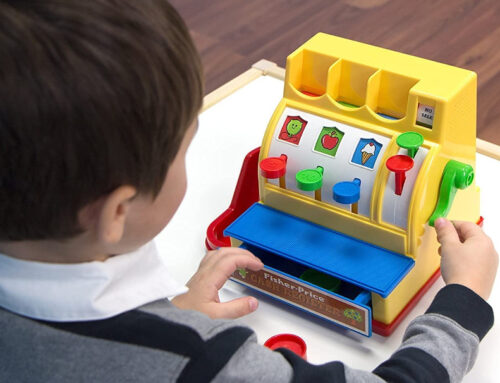It is always a big step when your child begins to understand and appreciate the playground games we all played as children. A favorite playground game for many children and “young at heart” parents/therapists at Blue Bird is Hopscotch! It can utilize beanbags, balls, and chalk and is a delightful way to pass the time. Below is a quick jump start into the world of hopscotch and its impact on your child’s physical development.
Hopscotch incorporates a variety of important gross motor movements including jumping forward, hopping on one leg, and motor planning these two activities together. Although it appears easy, hopscotch is often very frustrating for children. It is challenging to motor plan multiple motor tasks; therefore, certain foundational skills need to be addressed first.
Begin with basic visual markers such as single chalk squares or plastic dot markers to assist your child with jumping forward. A single handhold can be a helpful tool to build confidence and progress the forward movement of the jump. If jumping is a challenge, begin with sit to stands from a chair, squatting, and jumping with assist. Once your child appears confident jumping forward the single leg hopping can begin! Activities such as balancing on one leg, kicking a ball, and marching in place can all assist with the lateral hip and lower body strengthening needed to hop on one foot. If these tasks continue to be a challenge, please consult a Blue Bird physical therapist to help troubleshoot some of these challenging movements. These steps will take time, and it may lead to frustration, so providing meaningful praise and encouragement is also important for skill progression.

As each skill develops, your child will become ready to motor plan the entire hopscotch sequence. This is when the real fun begins! You can have them help you draw chalk outlines and numbers in each square. Single squares can begin one-foot hops and double squares can become jumps on two feet. The best part of hopscotch is that there are no set rules and you can adjust it and modify it to fit the skill level of your child.
Below are a variety of ideas for creating new and exciting hopscotch games!
- Hopscotch with animals-jump like dinosaurs, rabbits, kangaroos or whatever animal is the favorite that day
- Hopscotch with catching and throwing a ball – incorporate object manipulation by having your child catch the ball and then throw it at a number
- Utilize colors, animals, or shapes instead of numbers on your hopscotch line – sometimes numbers are boring and it is fun to jump to the kangaroo instead of the number 5
- Expand or shorten the hopscotch to the endurance level of your child
- Most importantly!! If you are able, play each hopscotch game with your child. They love seeing you jump and get excited with them. Make it a challenge and have fun playing with chalk outside! (or inside per parent discretion)

Blue Bird Day fosters socialization, sensory regulation, and pre-academic learning in children ages 2-7 years in therapeutic rotations that simulate preschool and kindergarten settings. Our compassionate therapists practice a relationship-based and family-centered approach, provide parent training, and collaborate on goals and individualized intensive treatment plans for your child.
We believe in a collaborative and multi-disciplinary team approach to therapy. A team of occupational therapists, speech-language pathologists, dietitians, developmental therapists, behavioral therapists, physical therapists, and therapeutic assistants are created for each child to ensure child and family are fully supported and the best possible results are achieved.
Options for individualized, group and virtual therapy sessions are available as well.
Want to learn more or you have a specific question? Feel free to connect with us here!



